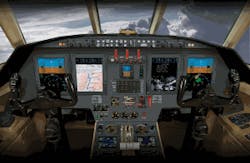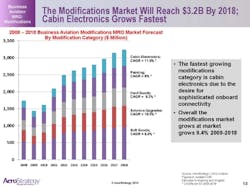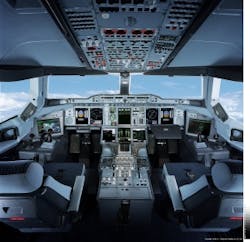Avionics retrofit outlook
By Charlotte AdamsThe commercial and corporate avionics retrofit markets are just beginning to recover after a deep and lingering recession. However, avionics companies continue to sell products and develop new ones. New communications, navigation, and surveillance products, as well as cockpit upgrades, will enable operators to meet expected mandates, increase efficiency and improve their access to airspace. Both Honeywell Aerospace in Phoenix and Rockwell Collins in Cedar Rapids, Iowa, have positioned themselves to offer many avionics upgrades via software with minimal aircraft downtime.In 2009 the airlines spent about $327.3 million on avionics upgrades, excluding parts and services, says Wayne Plucker, industry manager for aerospace and defense with Frost & Sullivan (F&S). F&S expects steady growth in the air transport retrofit market, hitting $672.6 million in 2012 and $804.2 million in 2014.The business aviation market suffered severely in the recession, taking a 25-27 percent hit to revenues between 2007 and 2009, Plucker says. He does not expect a real turnaround until 2012 or so. F&S defines business aviation to include everything from the luxury jets down to and including the Piper Meridian. F&S pegs the business aviation navigation retrofit market at $13 million in 2009, down to $11.5 million in 2010, but up again to over $47 million in 2014. Operators spent $35 million on communications upgrades in 2009, but were expected to more than double their expenditures by 2014. The business jet surveillance upgrade market hit $19 million in 2009, but will rise to $63 million by 2014, Plucker predicts.CommunicationsPlucker predicts "a decent uptick" over the next few years in air transport communications retrofits, in part because of preparations to meet controller pilot data link communications (CPDLC) mandates in Europe. CPDLC will allow routine air traffic control (ATC) clearances and instructions to be transmitted to pilots through the equivalent of airborne e-mail. Among other things, CPDLC requires a VHF digital link (Mode 2) (VDL-2) radio.The airlines spent $112 million on communications upgrades in 2009 and will spend $163 million in 2014, Plucker estimates. In the communications sector F&S also includes satellite communication (SATCOM) systems and transponders.New aircraft flying in European airspace were to have been equipped with CPDLC capability by January 2011, says Joel Otto, senior director of commercial systems marketing for Rockwell Collins. But the European Commission has issued a letter clarifying that there will be no operational restrictions in EU airspace imposed before
February 2013 for noncompliance with forward-fit requirements. By 2015 existing fleets are required to be up-to-date. For now, however, U.S. airlines equipped with future air navigation system (FANS 1/A) can get an exemption.Avionics solutions are just now getting approved, Otto says. Rockwell Collins has a certified CPDLC solution, the CMU-900, which can be used on air transport and some business aviation aircraft. CPDLC messages could be presented on flight management system (FMS) or forward displays. The company is doing follow-on message validation under a Federal Aviation Administration (FAA) contract for CPDLC in U.S. airspace. Honeywell also has a CPDLC solution. Users will need to update their displays via the FMS or a standalone display. NavigationThe airlines spent about $82 million on navigation upgrades in 2009, according to Frost & Sullivan, and that number was expected to rise to $128 million in 2010. "This is the tipping point for required navigation performance (RNP) and wide area augmentation system (WAAS)," Plucker says. He predicts that air transport navigation retrofits will reach $190 million by 2014, with FMS upgrades the biggest chunk. G2 Solutions believes that RNP/4D-related avionics upgrades in air transport will be worth about $804 million over the period 2008-2020.Honeywell's Pegasus FMS is being adopted by airlines such as American, United, and Delta, says Chad Cundiff, vice president of crew interface products. The company has also developed a "next gen" FMS system for the Gulfstream G650 and 747-8 that will be retrofittable to the 747-400.On the corporate aviation side, Primus Epic's FMS is a piece of software, Cundiff says. In a lot of cases, although you may have to change GPS receivers for WAAS capability, you can load a CD-ROM into the aircraft and download new functionality, he adds.Rockwell Collins' Next-Gen GLU-925 multimode receiver is aimed at air transport and offers a "selective availability-off" feature. Even though the Air Force turned off GPS selective availability years ago, a lot of equipment was delivered with selective availability assumed, Otto explains.On the business aviation side Rockwell Collins currently offers FMS capability to RNP 0.3 but plans to go down to 0.1, Otto says. At this time very few operators need to operate at RNP 0.1, he says. Most of the procedures have been developed to 0.3, he adds.There is a lot of discussion in the business aviation industry about more cost-effective ways to get down to very tight RNP levels, Otto says. RNP authorization required (AR) is beneficial on flights into places like Aspen, Colo., Vail, Colo., and Jackson Hole, Wyo., especially on missed approaches. However, the training and other requirements right now are "pretty onerous" for small corporate flight departments.Displays & cockpit upgradesG2 Solutions expects air transport display upgrades to be worth about $569 million from 2008-2020. Frost & Sullivan includes most displays in a much larger, surveillance category, which it pegs at $110 million in 2009, growing to more than $400 million by 2014.Cockpit upgrades are a big business for the avionics primes. Honeywell's Primus Elite allows operators of Primus 1000 and 2000 aircraft, which use first-generation integrated modular avionics (IMA), to swap out cathode ray tubes (CRTs) for liquid crystal displays (LCDs) and add features such as Jeppesen charts and uplinked weather. This can be done "inside of a week," asserts Cundiff, because the equipment has been developed as a form and fit replacement for the older displays. Primus Elite is used as an upgrade to the Embraer Legacy 600 and a forward fit to the Legacy 650.Primus 1000 and 2000 operators can also get the "FMS 6.1" upgrade, which is basically a software update installed on the IMA, Cundiff says.Traditionally, Rockwell Collinsâ Falcon 50 and King Air upgrades were a big portion of its business aviation retrofits. But the company now sees a "much stronger future" upgrading Pro Line 4 aircraft, including the Beech Jet 400A, Falcon 50EX, Falcon 2000, Falcon 2000EX, and Challenger 604, Otto says. Rockwell Collins offers Pro Line 4 operators the ability to move up to Pro Line 21, swapping out CRTs for larger-format LCD displays, providing the ability to add weather radar and synthetic vision over time. When aircraft are upgraded in this fashion, the FMS is updated to include features such as LPV, or localizer performance with vertical guidance. The makeover also adds graphics capabilities for situational awareness, such as maps, charts and graphical weather, and enables operators to take advantage of airspace opportunities such as CPDLC and automatic dependent surveillance-broadcast (ADS-B).While head-up displays (HUDs) are primarily a forward-fit business, Rockwell Collins sees some retrofits when aircraft change hands. With the company's HUDs standard on the 787, it hopes that airlines which also operate 737s or 777s may be more motivated to adopt the equipment for commonality of crew training, safety benefits and operational credit.ADS-B and integrated surveillanceEurocontrol has proposed mandates for (ADS-B) Out and traffic collision avoidance system (TCAS) Change 7.1 that will generate retrofit business. ADS-B Out requires a Mode S transponder with extended (GPS) squitter, broadcasting an aircraft's ID, position and altitude. European forward-fit ADS-B Out requirements are expected in 2015 and retrofit completions by 2017-2018. U.S. aircraft owners will have to adopt ADS-B Out in relevant U.S. airspace by 2020.
ADS-B In is also on the horizon. Rockwell Collins is developing a traffic computer which will combine ADS-B In applications and TCAS 7.1. This product, known as the TTR 4000, is aimed at the business and regional jet market, with entry into service slated for the second half of 2012.Honeywell has already developed a traffic computer, the TPA-100B, a TCAS upgrade which includes TCAS Change 7.1 and ADS-B. This traffic computer is at the heart of the companyâs new CAS 100 traffic surveillance system, which is designed to meet future surveillance and ADS-B needs, including the Airbus Airborne Traffic Situational Awareness (ATSAW) system.Last year Honeywell announced Turkish Airlines as the first customer to select its SmartTraffic offering, which enables ATSAW. SmartTraffic software combines ADS-B In and CAS 100 together and uses a more intuitive traffic display. So far there are three SmartTraffic applications: airborne traffic situational awareness, enhanced visual separation on approach and in-trail procedures in oceanic airspace (ITP).Honeywell has worked with the FAA and United Airlines on ITP demonstrations over the Pacific Ocean, out of radar range, using a TPA-100B derivative, an electronic flight bag (EFB) and a TRA67B transponder.Currently huge separation is required between aircraft that are out of radar surveillance. Aircraft cannot climb to more efficient altitudes as they burn off fuel. ITP could yield fuel savings of $100,000 per aircraft per year on transoceanic flights. Eventually separation could be reduced from 20-40 nautical miles to 10-15 nautical miles, Cundiff says. Honeywell also touts its software upgrades to its enhanced ground proximity warning system (EGPWS), known as SmartRunway and SmartLanding. SmartRunway is a set of callouts for increasing situational awareness around the runway. SmartLanding provides alerts to ensure an aircraft has a stable approach and is not coming in too fast, too low or too high.


